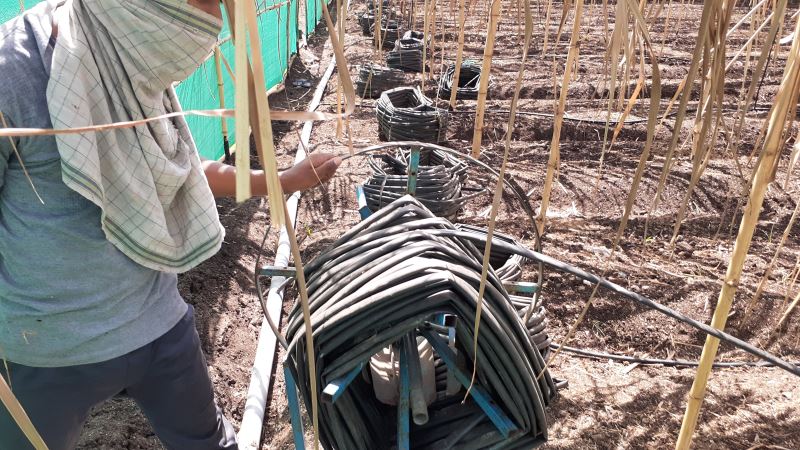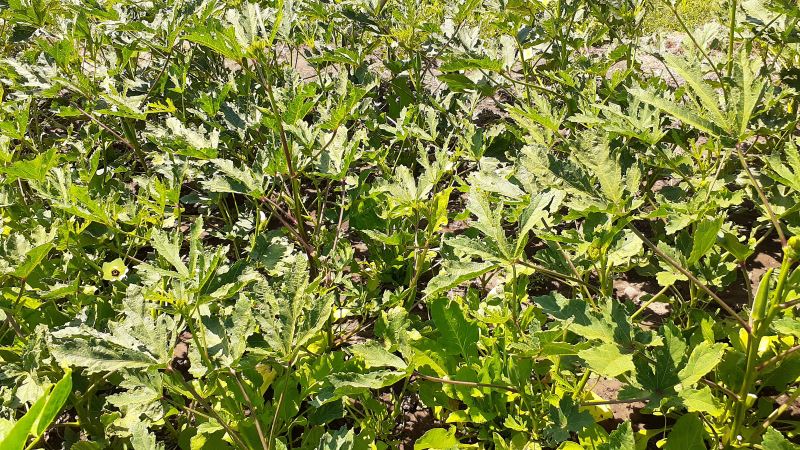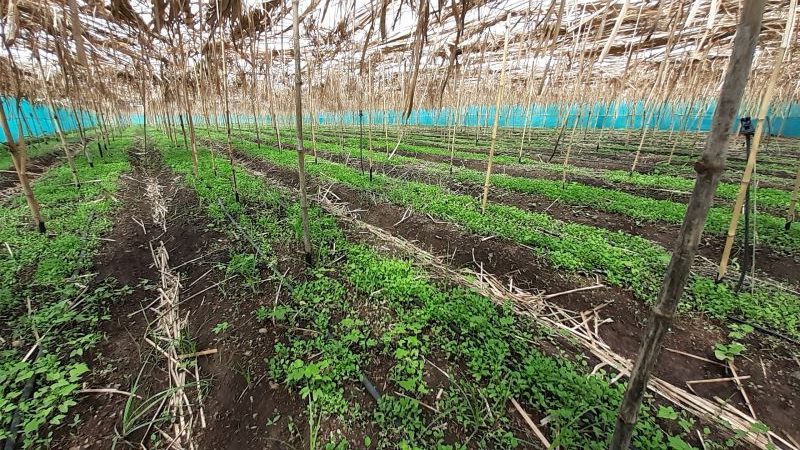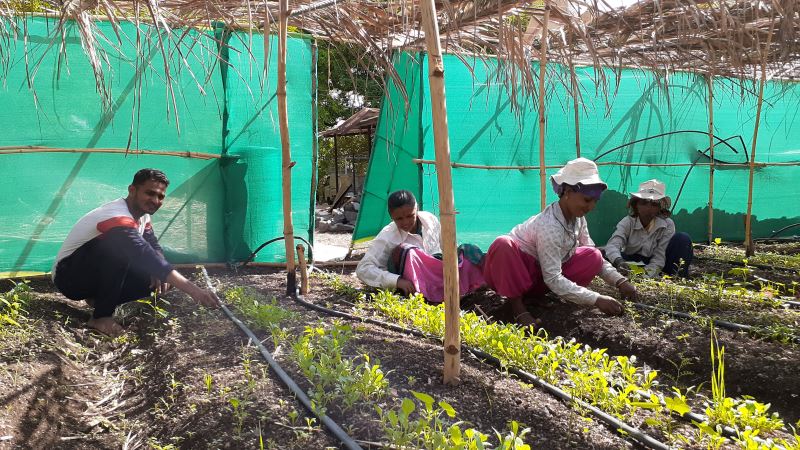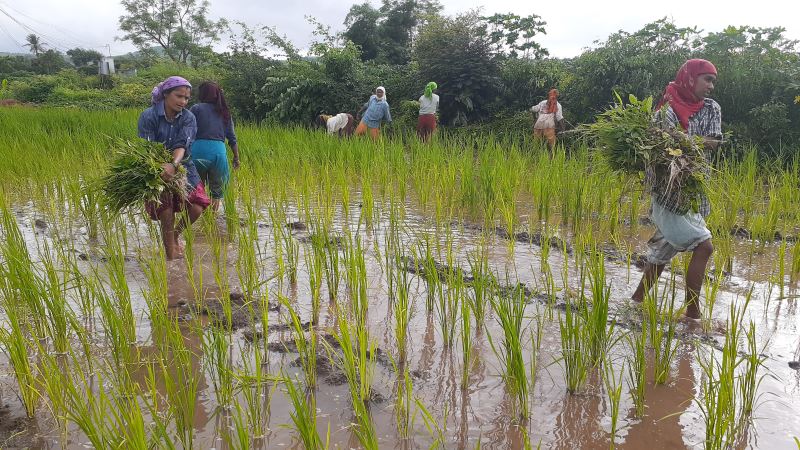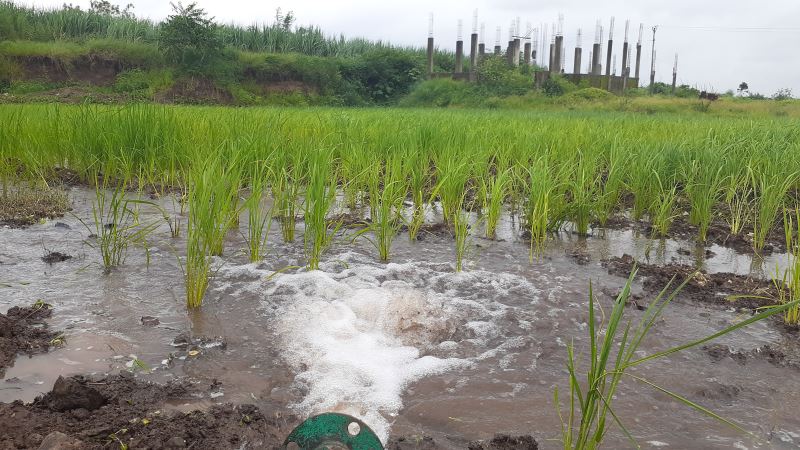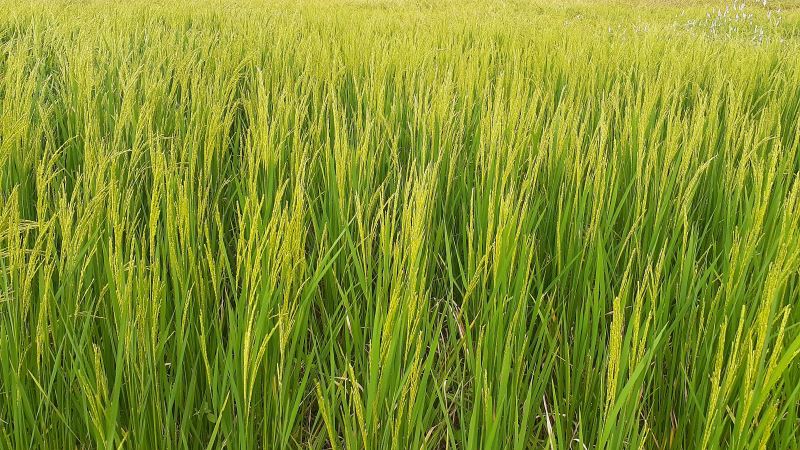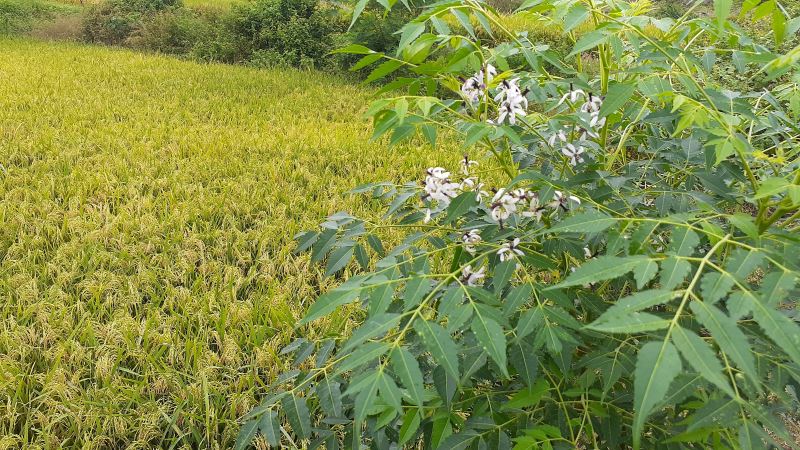Innovative Model Farms
Why Multi-Layer farming?
The state of Maharashtra in India has been faced with severe drought conditions in several areas over the last few years. Agricultural productivity, and in turn farmer incomes in the state, have taken a hit. As a consequence, the lives of farmers have been affected to a large extent. Farmers shifted to cash crops and have resorted to purchasing food grain: this is more expensive. Now their purchases mainly satiate hunger (rather than nourish them), which compromises their family’s nutrition and health. In order to address the problem of insufficient food for the family and inadequate nutrition in the face of a changing climate, multi-layer farming was introduced.The Process of Multi-Layer Farming
A one-acre plot of land was identified to build the multilayer farm. Crops were selected based on their height and duration of growth to ensure adequate sunlight and different harvesting periods so that farmers have continued access to different kinds of produce throughout the year. Sowing was also done in a strategic manner so that multiple crops including fruits, vegetables and flower crops could be grown together in the small plot of land. The drip irrigation method, which uses less water, and organic farming practices were adopted. Apart from these, there is a lot more science that goes behind the practice and activities that are part of multilayer farming. It needs to ensure that the process is sustainable, organic, and productive in the face of climate change and that family nutrition needs are eventually met. The produce can be old on a weekly basis; thus, some additional profit was also obtained from this process.The benefits for farmers
The purpose of the initiative was to make farmers more self-reliant, better-equipped and resilient in the face of recurring droughts – and climate change in general. Multi-layer farming incentivised them to switch to a more sustainable kind of farming and simultaneously meet the food and nutrition requirements of the entire family, while also generating income from cash crop production. Since the productivity was high and less water was required, a lot of the farmers said that they would like to start the farm.Land Treatment
Neem powder reduces alkalinity in soil, as it produces organic acids on decomposition. Being totally natural, it is compatible with soil microbes, improves rhizosphere micro flora and hence ensures fertility of the soil. We also care about soil acidity because of the way it affects plants and their growth. Some plants thrive in acidic soils, while others cannot tolerate acid and will prefer a basic environment. To reduce soil acidity and help neutralize its negative effects, we can add natural limestone, in a fine granular or powder form. Limestone is primarily composed of calcium carbonate, but many contain small amounts of clay, silt and dolomite. The magnesium content of limestone is especially important if soils are deficient in this essential plant nutrient. If a soil test indicates low magnesium, dolomitic limestone can be used to correct the deficiency and properly adjust pH. In a nutshell, the addition of limestone is done primarily to reduce acidity but may also provide some nutrient value. Before starting with any plantation on the anti-bacterial feed (neem powder). We spread a mixture of 100 kg Lime (Chuna) dust and 50 kg neem powder on 1 Acre of land.Farm Construction Story
We treated the land and prepared the soil with 4 tons of cow dung. Cow dung was purchased from a local farmer. From one ton of cow dung, we prepared ghan-jiwamrit, an organic fertilizer to use while plantation time. We have completed all procurement of bamboo from local farmers. Now we were in need of additional hilly grass to cover the roof. Farmers usually burn this grass in summer times, so we were able to prevent this. Total 3 trollies of grass collected to cover the roof. We cut this grass with the help of local tribal people where we required a total of 18 man power.
Due to Covid-19, the Indian government announced lockdown for 21 days which got continued for the next 4 months. Because of this, we had to stop our agricultural activities. Later on, government permitted agriculture-related work and we were able to continue the work. Due to this crisis, local panchayat and public sealed the village border from going and coming from outside. The sealing time was from morning 9 AM to the evening 6 PM. Most of the tribal people are daily wage farm laborers and cover daily living expenses through farm work they do. Our farm is 15 km far from our place. For maximum benefits from this project, we needed to plant in April or May month. We were in hurry to finish the work, so we started going out of the village before 8 AM and came after 6 PM from the work. We completed our work in time and provided some income to tribal people in this crisis to cover daily living expenses. Again, our work stopped, due to which we were not able to buy GI wires from hardware shops. We purchased this wire from 2 to 3 shops on different dates and continued the work. At last, we still lacked for 18 gazes G.I. (Galvanized Iron) wire. Finally, we purchased S.S. (Stainless Steel) wire 50 km far from the farm location. We completed whole work with the help of more than 35 tribal of total 180 man power days.
After purchasing wire, we completed the remaining work of making a mesh of wire on the roof. We put dry grass and coconut branches on top and tied them with string. We bought a green shade net to cover 8 feet boundary wall to prevent insects, animals, hot airflows, cold airflows to come into the farm. Now the farm was ready to start a plantation and sowing.
- We planted 20 different types of crops to generate revenue throughout the year with all-season crops. The reason behind planting such crops was to have a sustainable income from farming throughout the year.
- We planted 3 types of rhizome crops – Ginger, Turmeric and Mango Ginger
- Five types of leafy vegetables – Fenugreek, coriander, spinach, amaranth, dill
- Fruit Vegetables – Guar, Tomato, Kanthari Chilli
- Climber vegetables –3 type varieties of indigenous Ridge gourd, Sponge gourd, Cucumber, Bitter gourd, Bottle gourd, French bean, Ivy gourd
- Fruit – Papaya
- Trap crop – Marigold
We did plantation with the help of local tribal women, we applied prepared organic fertilizer (ghan-jiwamrit) at the time of planting. After completion, we installed a drip irrigation system with the help of lateral pipes. We needed extra PVC and fitting materials to fix the drip irrigation system. Considering the hot climate, we also installed a sprinkler system into the farm for summer. We installed all the systems by ourselves and it was great learning to understand flow pressures of pipe and fixing system. It took a total of 30 women power days to complete whole plantation and weeding work.
After the drip installation, we started watering the crops and it was the time to spray organic liquid fertilizers to plants. We purchased electric spray pump to spray organic liquid fertilizers as well as organic pesticides. The next step was weeding work, which we did with the help of tribal women. We did all the weeding work step by step and according to the plant. As organic farming is a labour-intensive process, we did the weeding process 5 times in a total of 40 women working days.
We harvested all the leafy vegetables and currently, climber vegetable harvest is going on. To protect climber vegetables from fruit flies and insects, we have installed yellow traps and fly traps. We are serving more than 112 families; the number is increasing day by day. We are also delivering our organic vegetables to the Sahyadri school organization having 250 residential staff. Many people are demanding for our organic vegetables. Due to toCovid-19, it made difficult to sell our harvest because all markets were closed due to lockdown. Still, we are struggling to sell our harvest, but we are managing it with a good network.We started this project with planting 6 types of indigenous varieties of rice in one acre. Each of rice variety is nutrient rich and having marketing demand. Sahyadri school helped us in rice seeds, plantation techniques and will also help to sell the rice.
We treated the seeds with indigenous method of using cow urine, soil and cow dung. We purchased 1 trolley of tractor of cow dung to mix it in soil to increase soil fertility. This cow dung spread in the soil with local tribal youths.
The remaining farm activities such as plantation and weed management are done with help of tribal women. All activities done under guidance of Mr. Dadabhau Jachak, who is our mentor in organic farming techniques. Sahyadri school also helped us in plantation techniques and local farmer helped us to do tillage work through ox.
We have planted 6 types of indigenous rice varieties in one acre – 1. Chakhaw (Black Rice), 2. Red Rice( Kuruwa), 3. Tamkud, 4. Kumud, 5. Jondhli Jirga, 6. Ghansal.
The rice varieties are growing nicely and we are giving organic liquid fertilizers(jiwamrit).
ALL CONTACTS
- At Village - Dhamari, Dhamari-Pabal Road, Tehsil - Shirur, Dist. - Pune, Maharashtra, India - 410505
- +91 7709 920 155
- contact[at]agrorangers[dot]org
- siddhesh[at]agrorangers.org[dot]org
SUBSCRIBE
Subscribe to our newsletter to read quarterly newsletters
Gallery
- All Rights Reserved - Copyright 2022


